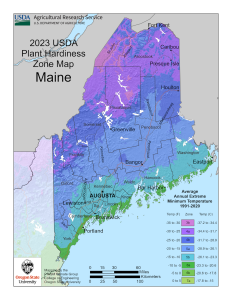USDA Plant Hardiness Zone Map
Interpreting the Plant Hardiness Zone Map
Updated: November 17, 2023 by Jonathan Foster, Horticulture Outreach Professional

How does this Hardiness Zone Map differ from the old one?
- The new map is based on approximately 30 years of weather data, from 1991 to 2020, and recommendations from a multidisciplinary panel of experts. Climatologists in the field are also using this recent data.
- Maine’s temperatures now appear slightly warmer. Part of this “warming” may be a result of higher resolution due to the use of GIS techniques in the new map.
What do the Hardiness Zones mean?
- Maine spans Plant Hardiness Zones 3-6. Each zone is based on the 30-year average of the single coldest temperature recorded each winter. Zone 3 is 10 degrees F colder than Zone 4, etc. In addition, each zone is split in half. For example, sites in Zone 4a reach an average low temperature of -30 to -25 F, while sites in Zone 4b reach an average winter low temperature of -25 to -20 F.
What do the Hardiness Zones NOT mean?
- The map is a guideline, not a guarantee. A plant rated hardy to Zone 4b would likely thrive in Zone 5a, do well on good sites in Zone 4b, and might survive in quite protected sites in Zone 4a.
- The map does not consider other factors that affect plant survival: summer temperatures and heat accumulation, length of growing season, depth of snow in winter, exposure to wind, soil drainage, soil fertility, quality of plant specimens, and management practices.
- The map is more accurate for trees and shrubs than for herbaceous perennials like iris and poppy, because snow cover greatly affects the winter survival of herbaceous perennials. An herbaceous perennial in a cold location with deep, reliable snow cover may survive better than one in a warmer zone where the ground is exposed to winter air.
How can you best use the map to select landscape plants?
- The source map (USDA) offers a new personal zip code finder. Simply type in your zip code to determine your cold hardiness zone.
- Be conservative when trying new plants. To be more certain about a new plant, buy a species rated one-half or even one full zone colder than the site is rated.
- Buy the best quality plant available. Follow good planting practices–water well during the establishment period (this can be several years), fertilize as recommended, scout for problems and resolve them promptly–and reach out to the UMaine Cooperative Extension before purchase or planting with any questions you may have regarding siting and proper care of the prospective plants.
From the GardenPro Answer Book, revised and updated by Lois Berg Stack, Ornamental Horticulture Specialist, University of Maine Cooperative Extension.
